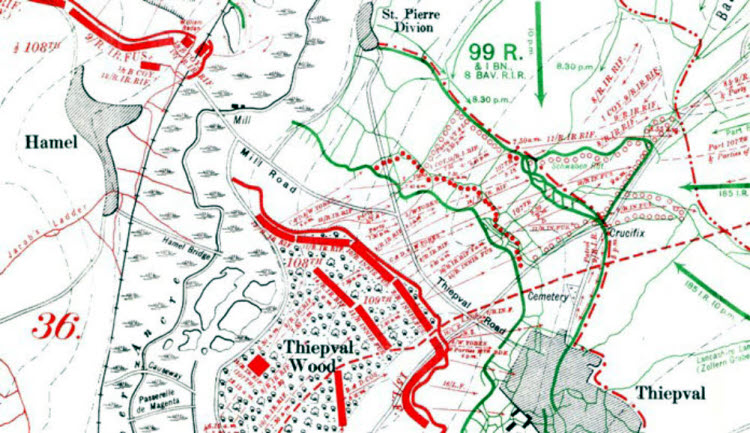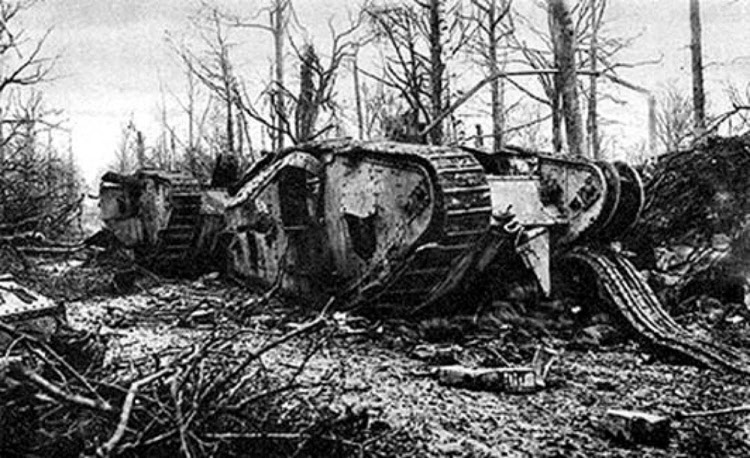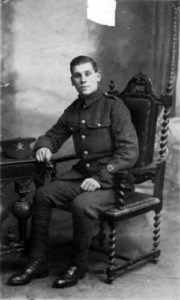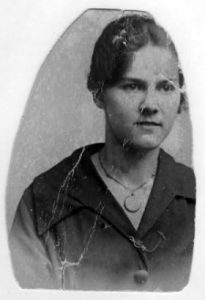
8382, Machine Gun Company 108th Brigade: 24162, Yorkshire Regiment (Green Howards)
Albert Newton was born in Netherton on the 30th July 1897 and was baptised at Middlestown St Luke’s and Netherton St Andrew’s Church on the 30th September 1897. He was the ninth of ten children born to Darton miner Charles Newton and his wife Clara (nee Sykes), who were married at Thornhill Parish Church on the 26th December 1880. Charles, aged 26, signed his name and Clara, aged 20, made her mark in the register. By March 1881, the couple were lodging, with their first born, on South Lane, Netherton, next door to Clara’s parents. Charles was working as a miner at that time, but by 1891, and by now the father of five children; all sons, he was working as a railway engine stoker and still living on South Lane, Netherton.
Then, on the 20th April 1897, tragedy struck the Newton family when Charles was crushed by a railway engine during a shunting operation at the colliery sidings. The “Yorkshire Evening Post” in April 1899 had this report of the accident:
“Between the Buffers – A shocking fatality occurred at Shitlington, near Wakefield yesterday. A man named Charles Newton, aged 45, of South Lane, Netherton, was engaged in shunting operations at the colliery sidings at Shitlington, when he was crushed between the buffers. He died almost immediately.”
Only 45 years of age, Charles Newton was buried, by Coroner’s Order, on the 22nd April 1899 at Thornhill St Michael and All Angels’ Church, Thornhill. Albert Newton was three months shy of his 2nd birthday. In 1901 Clara, a widow aged 41 years, was living with her 10 children, 8 sons and 2 daughters, at her South Lane, Netherton home. The eldest child was 21 years of age and the youngest was one year old.
With little option but to marry again to provide for herself and her children, Clara Newton married coal miner, Thomas Andrew Ward in 1905. By 1911, the couple were living at Horbury Bridge, Middlestown with four of Clara’s children, including Albert, now aged 14 and working as a scale picker at the local colliery.
This then was Albert’s life before war broke out in August 1914. He was the ninth child of ten, and the second youngest son and he was not yet two years old when he lost his father in tragic circumstances. Working at the colliery by the age of 14 years and living with his mother and new stepfather, he must have wondered if this was all there was and what he might make of his life. Then, along came the War. His six elder brothers were of an age when they would be expected to serve and fight for their country. Albert Newton was 17 years and 4 days old when Britain declared war on Germany on the 4th August 1914. In the ordinary course of events, he could not sign up until his eighteenth birthday, in July 1915 and he would not be able to serve overseas until his nineteenth birthday, in late July 1916.
His army service record has not survived, but it is known that he enlisted in the Yorkshire Regiment (The Green Howards) and was allotted the service number 24162. He was subsequently awarded the British and Victory medals for his 1914-18 service, but not the 1914-15 Star, indicating that he did not serve overseas before the 1st January 1916. At some stage, probably in January 1916, he was transferred to the Machine Gun Corps (MGC) with service number 8382. This suggests that, earlier than January 1916, he was training in the UK as a machine gunner in the Yorkshire Regiment, indicating that he would have volunteered to serve sometime during 1915; perhaps in July 1915, when he became 18 years of age. His presence with the 108th MGC in January 1916 also means that, contrary to the established practice at that time, Albert served overseas before his 19th birthday.
In early 1916, he was posted to the 108th Machine Gun Company (MGC), which was formed about that time at Ribeaucourt, Northern France and they joined the 108th Brigade of the 36th (Ulster) Division on the 26th January 1916. The 108th MGC strength at the 1st February 1916 was 9 Officers and 141 Other Ranks. The 108th Infantry Brigade strength, of which the MGC was a part, was 122 officers and 3942 other ranks. The 108th Infantry Brigade at this time comprised four Infantry Battalions, the 11th, 12th and 13th battalions of the Royal Irish Rifles and the 9th battalion Royal Irish Fusiliers. The Ulster Division’s companion Brigades, the 107th and the 109th were similarly comprised of Irish Regiments. These Brigades and other troops made up the 36th (Ulster) Division.
On the 3rd September 1914, just short of a month after Britain had declared war, and after much discussion regarding what amounted to a political ‘truce’ with regard to domestic matters, Sir Edward Carson (one of the great political leaders opposing Home Rule for Ireland) made an appeal at the meeting of the Ulster Unionist Council in Belfast, urging the men of the Ulster Volunteer Force to come forward for service in the defence of the British Empire. Despite the fact that many Ulstermen had made their own decisions and had already enlisted, an entire formation known as the Ulster Division was soon raised – and all of its infantry units were based on existing units of the UVF. Thirteen battalions were raised for the three Irish regiments based in Ulster: the Royal Inniskilling Fusiliers, the Royal Irish Fusiliers and the Royal Irish Rifles.
In July 1915, the Ulster Division moved to Seaford on the Sussex coast of England. Lord Kitchener inspected the Division there on the 27th July 1915, and later remarked to Carson “your Division of Ulstermen is the finest I have yet seen”. Another inspection took place, by King George V, on the 30th September. In early October 1915 the Division moved to France, although the artillery remained in England until November. The Ulster Division initially concentrated in the area around Flesselles, some ten miles north of Arras. Gradually, men were sent in groups for familiarisation with trench warfare conditions, and were attached to the regular army 4th Division for the purpose in the (at this time) quiet area north of the River Ancre near Albert, France.
On the 21st October 1915, the Division was moved away from the fighting area towards Abbeville, where it spent most of the winter of 1915-16 continuing training. One of the Brigades was attached to 4th Division for several weeks at this time and the artillery finally rejoined. The whole Division finally took over a complete section of the front line on the 7th February 1916, between the River Ancre and the Mailly-Maillet to Serre road. Division HQ was at Acheux. In the first week of March 1916, the Division extended its front, the 109th Brigade taking over the sector south of the Ancre, known by the name of Thiepval Wood.
In March 1916 the 108th MGC was stationed at Englebelmer, some four miles west of the front line and by late April they moved to Martinsart some three miles from the front line at Thiepval. They remained here until late June 1916 when they moved forward in the Thiepval and Hamel sections in readiness for the attack. This was first set for late June but weather delays forced re scheduling until 1st July 1916. 3 Machine Guns were to accompany the 11th & 9th battalions Irish Rifles and 2 Machine Guns were to accompany the 12th & 13th battalions Irish Rifles. The remaining 6 guns of the 108th MGC had been involved in artillery bombardment support during previous nights and were to be held in reserve to cover attack and meet emergencies. They were to move forward as circumstances allowed under orders from the Senior Officer. The total strength of the 108th MGC on 1st July 1916 was 11 Officers and 156 Other Ranks and they were positioned in the right centre section Thiepval Wood and left Hamel sub sector.
Gunner Albert Newton encountered his first serious action here at Thiepval, in what came to be known as the Battle of Albert on 1st July 1916, the first day of the Battle of the Somme when the 36th (Ulster) Division attacked at the Schwaben Redoubt near Thiepval.

Above: This map shows the ground over which the Ulstermen attacked on the 1st July 1916. Their front line skirted the northern edge of Thiepval wood, facing a gentle upward slope toward Schwaben Redoubt, a defensive complex in the second main German trench system north of Thiepval.
That was the plan. In the event things didn’t go quite according to plan and the 108th Infantry Brigade casualties on the 1st July 1916 totalled Officers killed 19, wounded 41, missing 16. Other Ranks casualties comprised 232 killed, 1,021 wounded and 622 missing. Of these totals the 108th MGC casualties were Officers killed 3, wounded 3, missing 1: Other Ranks killed 16, wounded 38, missing 5. The whole 36th (Ulster) Division was relieved on 2nd July, having suffered 5104 casualties, of whom approximately 2,069 died. On that day 108th MGC was moved back to Martinset, 3 miles to the west of the front line. They received reinforcements on the 8th July and by 20th July 1916 the 108th Brigade had entrained some 60 miles north and was now camped near Poperinghe to the west of Ypres in Belgium. For battalions suffering significant losses it was the practice to move to the Ypres area where the action was less intense and troops could recuperate and retrain in readiness for moving back into France for more major action. Ypres and its mud was to be home for Albert Newton for the next 13 months.
That’s not to say that there was no action on the Ypres front, but the allied and enemy forces were content to hold what they had. In October 1916 the 108th MGC were positioned at Ploegsteert Wood known to be a quiet section of the Ypres Salient at that time but, like the other sections of the Ypres front, it was subject to frequent enemy shelling, troop forays and gas attacks. Albert Newton and his 108th MGC spent a wet and cold winter and spring 1917 in various locations around Ypres (pronounced Wipers and ironic that after WW1 he married a lass called Ada Wiper). On the 1st June 1917, the 108th MGC were in trenches south west of Ypres, at Kemmel Hill, the highest hill position on the Ypres Salient and consequently an important military objective for allied and enemy forces.

Above: A British Vickers machine gun of the Machine Gun Corps set up to shoot at German aeroplanes. Albert Newton would have operated a machine gun like this.
In the following days the 108th Brigade, including the 108th MGC moved into their positions in readiness for the Battle of Messines and the capture of Wytschaete between the 7th and 14th June 1917. In the run up to the Battle the MGC fired between 70,000 & 110,000 rounds per night between the 2nd and 5th June.
Zero hour for the attack was at 3.10 a.m. on 7th June 1917. The Regimental War Diary for the 108th Brigade HQ reported the opening salvo; The mines ….were blown successfully and created enormous earth tremors which, joined with others on the 9 mile front of attack, were felt in England. This was the signal for the opening of the artillery which opened simultaneously on its allotted targets which continued practically without cessation throughout the day and far into the succeeding night.
On the 8th June the MGC had 14 guns in open emplacements to cover the final objective (known as Black Line) and two guns in the Black Line for direct fire. Notwithstanding the intensity of fire, the MGC appeared not to suffer significant casualties.
The 108th were in action again in early/mid August in the Battle of Langemarck on the 16th & 17th August. In readiness for this battle the 108th MGC employed 8 guns moving into position on 5th August when they suffered woundings to an officer and 4 other ranks. On 7th August the MGC increased its armoury to 16 guns as the attack intensified and the MGC encountered sporadic wounding of men over the next week. On 16th August, a key day in the attack the MGC lost 2 officers and 1 other rank with 11 men wounded and 1 man missing. The allied attack had been repulsed and the Irish Infantry Brigades had fared much worse on that day with 111 men killed, almost 650 wounded and more than 300 men missing in action.

Above: Men of the 16th Irish Division with souvenirs of the capture of Wytschaete. Near Bailleul, 11 June 1917 after the Battle of Wijtschate-Messines Ridge.
Their job done as well as it could be, on the 18th August, the 108th Brigade was relieved and bussed back to Winnezeele in northern France some 15 miles due west of Ypres, Belgium. From there they were entrained 75 miles south to Miraument , 8 miles north east of Albert, France. They were back on the Somme. The 108th Brigade HQ Regimental War Diary for the 24th August 1917 recorded; All units are billeted in Nissen huts in the immediate vicinity of Brigade HQ. The neighbouring country has been laid waste by the enemy in March 1917. There are no civilians. The weather is breezy and clear. Newspaper report of attack of brigade which relieved us south of St Julien suggests almost the same result as in our case.
By the 31st August 1917, the MGC had moved 16 guns into the front line near Ytres, a small farming village, 20 miles south east of Arras, France. The 108th MGC strength was 12 officers and 169 men. Enemy attacks in September 1917 were frequent and intense but they were successfully repelled by the 108th Brigade. Remarkably, the MGC suffered only 2 men wounded in September and the MGC, and the rest of the 108th, finished the month with more troops, due to reinforcements and few losses.
October 1917 saw fewer attacks by the enemy and some forays by the 108th into enemy territory. By the standards of the time it was an unremarkable month. On the 3rd November a party of almost 100 men from the 108th raided the enemy front line under cover of trench mortar and machine gun fire. Hand to hand fighting ensued as the enemy refused to surrender and many were killed. The 108th lost 4 men with 15 wounded. On the 16th November, the 108th MGC moved from Neuville to Barastre, south of Bapaume and then to Velu, 20 miles south of Arras in readiness for a further allied attack planned for the 20th November 1917. This was to be known as The Battle of Cambrai and it was followed on 26th and 27th November by the Capture of Bourlon Wood.

Above: Two wrecked British tanks in Bourlon Wood, during the Battle of Cambrai in November 1917.
The 108th MGC strength at the end of November 1917 was 6 men lower than at the beginning of November, suggesting some losses and/or wounded. There was heavy enemy bombing and hostile aircraft action in early December 1917, a phase known as the German Counter Attacks, which became much more intense such that by the 15th December 1917, there was considerable hostile aerial activity and at 5 p.m. the enemy captured a machine gun from the 108th MGC and a gunner was killed. Enemy action continued on the 16th December, but was driven back, allowing the 108th to establish a post at Metz, 3 miles east of Ytres. The casualty record for the 108th MGC on 15th December records one man killed and another man wounded.
 It was most probably in this action that Gunner Albert Newton received an injury. He was evacuated to the 18th General Hospital, at Camiers, near Boulogne, where he was admitted with an injury to his left hand on the 17th December 1917. The hospital admission record shows it to be an injury and consequently, it may not have been a wound, although it may have been recorded as such in the 108th MGC casualty records. Albert was stated, correctly, to be 20 years old and he remained in hospital until he was discharged on the 19th February 1918.
It was most probably in this action that Gunner Albert Newton received an injury. He was evacuated to the 18th General Hospital, at Camiers, near Boulogne, where he was admitted with an injury to his left hand on the 17th December 1917. The hospital admission record shows it to be an injury and consequently, it may not have been a wound, although it may have been recorded as such in the 108th MGC casualty records. Albert was stated, correctly, to be 20 years old and he remained in hospital until he was discharged on the 19th February 1918.
Since Albert would have been struck-off the strength of 108th MGC upon admission to hospital, it is unlikely that he returned to the same unit after his release. The normal practice was for men to be returned to the MGC Base Depot – also at Camiers – where he would have been reallocated to a new unit. An added complication was that on 1st March 1918 the British Army reorganised and the Machine Gun Companies became structured at the Divisional rather than the Brigade level. This meant that, from this date, the 108th MGC formed part of 36 Battalion MGC. No evidence has been found to indicate the specific WW1 whereabouts of Gunner Albert Newton (shown left) after this date.
Nonetheless it is highly likely that he would have been involved in repelling the German Offensive in March 1918 which became known as the Spring Offensive or Operation Michael (or if had been deployed to Ypres, Operation Georgette).
Wherever he was after mid-February 1918, Albert appears to have survived the war relatively unscathed, since he was discharged to Class “Z” Reserve on the 15th March 1919. This meant that the army regarded him as fit, and liable for recall in emergency.
His photographs indicate that when he was serving as a Private in the Corps, he had been rated as a 1st Class Machine Gunner. This meant that he had passed all the tests confirming that he was thoroughly proficient as a gunner on the Vickers Mk1 machine gun, and thus benefited from a slightly enhanced rate of pay.
Another photograph shows him as a Lance Corporal and therefore the No 1 of a gun team of six, and the man who actually fired the gun. He was discharged in the rank of full Corporal and returned home to Yorkshire around mid March 1919. He was subsequently awarded the British Medal and the Allied Victory Medal for his service during WW1. For most his service Albert served in the 108th Brigade of the 36th (Ulster) Division. This Division remained on the Western Front for the whole of WW1 and had 32,186 men killed, wounded or missing.
 All through WW1, Albert Newton carried this picture (left) of his future wife to be, Ada Wiper. Maybe this served as a lucky charm, because he was lucky to survive almost four years of heavy fighting during his time on the Western Front. He survived the horrors of the opening day at the Battle of the Somme and numerous other major battles, as well as spending months in the mud and trenches at Ypres. Albert Newton served in what was one of the most dangerous WW1 occupations of all, as a part of the the 108th Machine Gun Company or the “Suicide Squad” as it was colloquially known by the British Tommies.
All through WW1, Albert Newton carried this picture (left) of his future wife to be, Ada Wiper. Maybe this served as a lucky charm, because he was lucky to survive almost four years of heavy fighting during his time on the Western Front. He survived the horrors of the opening day at the Battle of the Somme and numerous other major battles, as well as spending months in the mud and trenches at Ypres. Albert Newton served in what was one of the most dangerous WW1 occupations of all, as a part of the the 108th Machine Gun Company or the “Suicide Squad” as it was colloquially known by the British Tommies.
At 2 p.m. on 3rd July 1920, Albert married 20 year-old Ada Wiper (born 1900 in Dewsbury) at Thornhill St. Michael and All Angels’ Church. Their first child, Dorothy was born in Spring 1921, followed by Clifford in summer 1926 and Stanley in Spring 1935. A fourth child, Joan was born in Spring 1942, and her daughter Ruth Jackson has helped considerably with this biography of her grandfather.
In 1939, Albert was living at 20, Roundwood and his date of birth was given as the 4th July 1897, which is at odds with the birth date recorded at his death. Albert was working as a Public Works Contractor Labourer in 1939 and living with his wife Ada (nee Wiper) born 19th May 1908 and his sons Stanley (born 7th June 1935) and Clifford. At some stage Albert also worked at Roundwood Colliery and lived close by at 230, Wakefield Road, Ossett. In later years, it is believed that Albert Newton and his wife Ada lived in Gawthorpe.
Albert Newton, born on the 31st July 1897 died in Spring 1970, aged 72 years.

Above: Albert Newton, circa 1964 at his daughter-in-law’s house in Tattersfield Street, Ossett. Albert’s granddaughter, Elaine is the little girl with the child’s pram. Elaine’s younger sister, Andrea (now Hartley) was in the big pram behind the fence.
Tattersfield Street in Ossett linked Littlefield Road and Greatfield Road and was demolished in 1969, and replaced by Greatfield Drive.
References:
1. http://www.longlongtrail.co.uk/
2. Machine Gun Corps Database By Graham Sacker Historical Research, MGC Database.
3. Regimental War Diary 36th Division 108 Infantry Brigade Headquarters 1915 Oct – 1919 Feb.